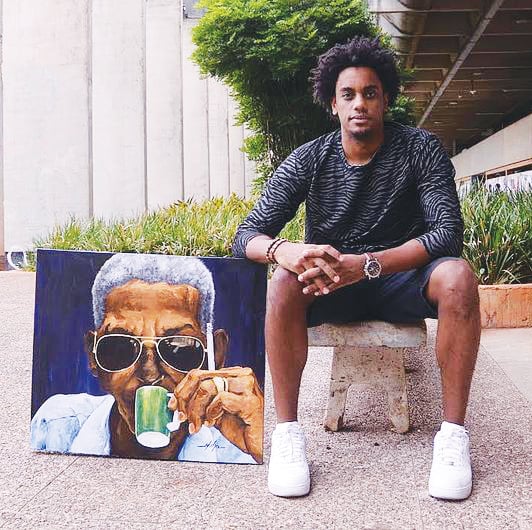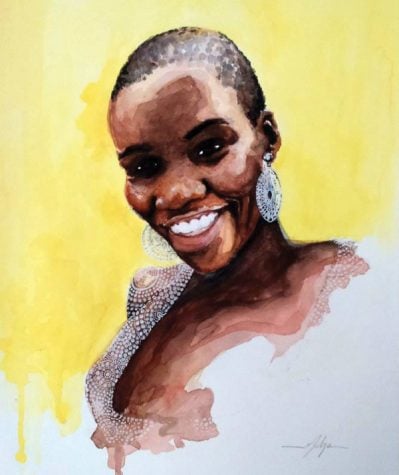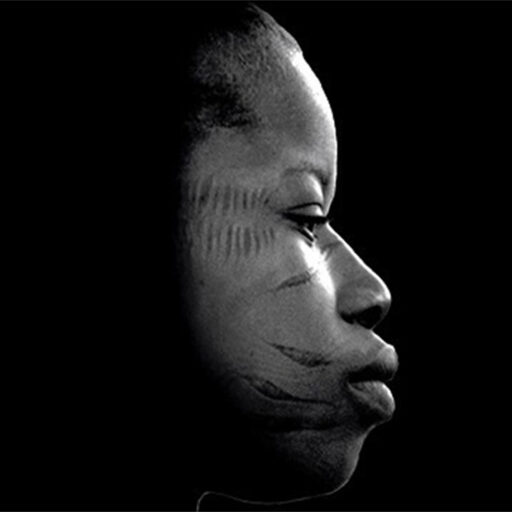Brazilian artist and architect Muha Bazila gave a lecture titled “A Reflection on Art, Representation, and Black Militancy.” He gave the lecture and displayed his artwork to a group of approximately 30 Luther College students, faculty members, and Decorah community members on Feb. 15. His artistic practice is a response to racial discrimination within art.
Por Olivia Enquist, do Luther College Chips

Photo courtesy of luther.edu
Muha Bazila poses with one of his portraits
Bazila discussed the racial inequalities in Brazilian education, his own cultural influences, and the importance of representation of people of color in art. A teacher and mentor of Bazila inspired him to combine his interests in art with his degree in architecture.
Bazila debuted as a painter with his 2014 series “Odara” which emphasized the beauty of black women in Brazil.
Since then he has presented his artwork in festivals in São Paulo, Paris, and New York City.
“I find it important to appreciate the black woman aesthetically, without necessarily sexualizing,” Bazila said in a 2015 interview with NoBrasil.

Photo courtesy of afropunk.com
Muha Bazila aims to bring more black female representation in art.
Bazila began the lecture by describing Brazilian geography and population statistics. He went into detail about the different states of Brazil, particularly the socioeconomic landscapes and ethnic populations
Some cities such as Brasília are ultra-modern in design and are segregated by economic class, while other cities such as Rio De Janero people of different socioeconomic classes live adjacent to each other.
Attendee Veronica Seher (‘17) said that the explanation of the different areas of Brail is vital in understanding differences in cultural influences.
“I’m really happy that the speaker provided information on Brazil’s different states,” Seher said. “It helped because it can be easy to forget how big Brazil is and that each city is unique especially in culture. You can especially see this diversity in music like samba. It reminded me that, similar to how cities here in the U.S. will feel different, so will cities in Brazil.”

Photo courtesy of luther.edu
An example of Muha Bazila portraits.
Overall, Bazila emphasized the importance of representation and how the ability to see oneself within art and culture should never be a privilege. He used photos to highlight the differences that currently exist in Brazilian culture, specifically in the state of Salvador.
Bazila used two photos to contrast differences. One photo depicted a protest that would normally be seen on the streets of Salvador, Brazil.
The second photo was of a beauty pageant in the same area. While the protest showed a diverse mix of ethnicities, the pageant contained only one person of color.
Bazila challenged the audience members to think differently about those representations in art. He described how friends and colleagues would ask why he only paints women of color.
He went further to say that few people question when an artist only paints white people, and that it should be normal for people to have access to media that accurately represents their culture and ethnicity.
Attendee Anna Phearman (‘19) studied in Brazil this past January term and appreciated how Bazila represented his country in a variety of ways.
“I would say what struck me most about his lecture was how he intertwined various elements of his background and experiences in Brazil in order to create unique portrayals of Brazilian culture,” Phearman said. “Having traveled to Brazil for this January term, I was happy to see Brazilian culture portrayed in such a way.”
Attendee Ryan Koning (‘19) was glad that Bazila explained the differences between representing a person from a different culture and appropriating that culture in art.
“I really appreciated that Muha Bazila talked about the importance of cultural representation in artwork and how there is a fine line that exists between representation and appropriation,” Koning said. “As a portrait painter, it is easy to get wrapped up into the subject without thinking about how the viewer may interpret them in an unintended way. Bazila helped me navigate how to represent cultures other than my own in an authentic and well-intentioned way.”

Photo courtesy of mariapreta.org
Muha Bazila paints portraits of women that are exclusively women of color.




